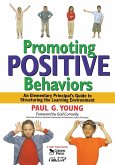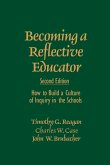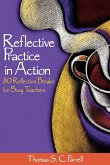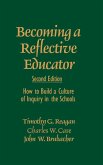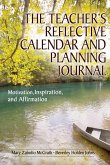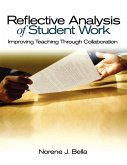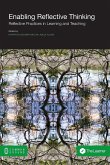- Gebundenes Buch
- Merkliste
- Auf die Merkliste
- Bewerten Bewerten
- Teilen
- Produkt teilen
- Produkterinnerung
- Produkterinnerung
`This book is very thorough in presenting the purpose and accompanying strategies for instilling reflective practices in educators. I believe the reflective thoughts and questions posed throughout are beneficial for teachers' - Karen Harvey, Santa Clarita Valley Beginning Teacher Support and Assessment (BTSA) This Second Edition integrates the latest research and technology with tried-and-true methods for boosting practitioners' reflective thinking skills. The tasks and tools provided have been specifically designed for facilitators of pre-service and inservice teacher education, training, and…mehr
Andere Kunden interessierten sich auch für
![Promoting Positive Behaviors Promoting Positive Behaviors]() Paul G YoungPromoting Positive Behaviors32,99 €
Paul G YoungPromoting Positive Behaviors32,99 €![Becoming a Reflective Educator Becoming a Reflective Educator]() Timothy G. ReaganBecoming a Reflective Educator42,99 €
Timothy G. ReaganBecoming a Reflective Educator42,99 €![Reflective Practice in Action Reflective Practice in Action]() Thomas S. C. FarrellReflective Practice in Action42,99 €
Thomas S. C. FarrellReflective Practice in Action42,99 €![Becoming a Reflective Educator Becoming a Reflective Educator]() Timothy ReaganBecoming a Reflective Educator81,99 €
Timothy ReaganBecoming a Reflective Educator81,99 €![Teacher's Reflective Calendar and Planning Journal Teacher's Reflective Calendar and Planning Journal]() Mary Zabolio McGrathTeacher's Reflective Calendar and Planning Journal28,99 €
Mary Zabolio McGrathTeacher's Reflective Calendar and Planning Journal28,99 €![Reflective Analysis of Student Work Reflective Analysis of Student Work]() Norene June BellaReflective Analysis of Student Work36,99 €
Norene June BellaReflective Analysis of Student Work36,99 €![Enabling Reflective Thinking Enabling Reflective Thinking]() Enabling Reflective Thinking46,99 €
Enabling Reflective Thinking46,99 €-
-
-
`This book is very thorough in presenting the purpose and accompanying strategies for instilling reflective practices in educators. I believe the reflective thoughts and questions posed throughout are beneficial for teachers' - Karen Harvey, Santa Clarita Valley Beginning Teacher Support and Assessment (BTSA) This Second Edition integrates the latest research and technology with tried-and-true methods for boosting practitioners' reflective thinking skills. The tasks and tools provided have been specifically designed for facilitators of pre-service and inservice teacher education, training, and development-giving them a timesaving blueprint on how to shape their adult learners into analytical and critical thinkers. Attuned to the challenges surrounding teacher training, this easy-to-use guide outlines straightforward activities and concrete assessments that serve as constructive benchmarks for facilitators and teachers alike. It delivers 50 practical strategies for helping educators move through the levels of reflective thinking - from teacher roles, styles, attributes, and observations through such far-reaching concerns as the moral and ethical considerations of teaching.
Hinweis: Dieser Artikel kann nur an eine deutsche Lieferadresse ausgeliefert werden.
Hinweis: Dieser Artikel kann nur an eine deutsche Lieferadresse ausgeliefert werden.
Produktdetails
- Produktdetails
- Verlag: Corwin
- 2. Auflage
- Seitenzahl: 276
- Erscheinungstermin: 11. Mai 2005
- Englisch
- Abmessung: 286mm x 221mm x 19mm
- Gewicht: 961g
- ISBN-13: 9781412909631
- ISBN-10: 1412909635
- Artikelnr.: 22137505
- Herstellerkennzeichnung
- Produktsicherheitsverantwortliche/r
- Europaallee 1
- 36244 Bad Hersfeld
- gpsr@libri.de
- Verlag: Corwin
- 2. Auflage
- Seitenzahl: 276
- Erscheinungstermin: 11. Mai 2005
- Englisch
- Abmessung: 286mm x 221mm x 19mm
- Gewicht: 961g
- ISBN-13: 9781412909631
- ISBN-10: 1412909635
- Artikelnr.: 22137505
- Herstellerkennzeichnung
- Produktsicherheitsverantwortliche/r
- Europaallee 1
- 36244 Bad Hersfeld
- gpsr@libri.de
Germaine L. Taggart is Associate Professor in the College of Education at Fort Hays State University, Hays, Kansas. She has taught students from kindergarten through Grade 12 in public schools in Kansas. She received her BS and MS degrees in Elementary Education from Pittsburg State University, her EdS in Educational Administration from Fort Hays State University, and her EdD in Educational Administration from Kansas State University. She teaches mathematics and science methods courses, has helped develop and continues to work with TEAM: Links for Learning (a field-based preservice program), and provides staff development on a consultant basis for school districts in western Kansas. Dr. Taggart is married to R. Bruce Taggart. They have two children, Travis and Kelsey, and one granddaughter, MacKenzie, and they reside in Hays, Kansas.
About the Authors
Chapter 1: Becoming a Reflective Teacher
Modes of Reflective Thinking
The Process Approach
Techniques for Facilitating Reflective Activities
Brainstorming
Consensus Building
Buzz Groups
Role-Playing
Questioning
Activities for Introducing Reflective Thinking to Practitioners
Task 1: Finding a Definition
Task 2: The Reflective Thinking Process
Task 3: Gardening Puzzle
Task 4: Roll On
Task 5: Designing a Classroom
Task 6: Logic Lure
Preparing a Plan of Action for Enhancing Reflective Thinking
Chapter 2: Assessing Reflective Thinking
Task 7: Atribute Clarification
Task 8: Card Sort: Reflective Thinking Attributes
Chapter 3: Practicing Observational Learning
The Observation Process
Reflective Activities
Task 9: Categorization of Observations
Task 10: Compliance With Classroom Rules
Task 11: Observing Effective Questioning
Task 12: Observing Classroom Management Styles
Task 13: Belief Systems: Their Role in Observational Learning
Task 14: Interpreting Change
Reflective Questions
Action Assignments
Suggestions for Success
Journaling Reflective Growth
Chapter 4: Writing Reflective Journals
The Use of Reflective Journals
Reflective Activities
Task 15: Task Formatting a Journal Entry
Task 16: Journaling the Reflective Thinking Process
Task 17: A Comparison of the Use of Journaling to an Observational
Checklist
Task 18: A Comparison of Observations With the Use of a Journaling Format
to Observations Without the Use of a Journaling Format
Task 19: Open-Ended Journaling
Task 20: Rights and Responsibilities
Reflective Questions
Action Assignments
Suggestions for Success
Journaling Reflective Growth
Chapter 5: Using Practicum Strategies
The Microteaching Process
Reflective Teaching
Reflective Activities
Task 21: The Anxiety Task
Task 22: Lines of Symmetry Task
Task 23: Effective Teaching Rubric
Task 24: Effective Teaching to Peers
Task 25: Inclusion: Teaching Effectiveness
Task 26: Effective Teaching of Peers
Reflective Questions
Action Assignments
Suggestions for Success
Journaling Reflective Growth
Chapter 6: Narrative Reflection
Autobiographical Sketches
Case Studies
Study Circles
Reflective Activities
Task 27: Using Case Study for Problem Resolution
Task 28: Using Autobiographical Sketches to Evaluate Beliefs Regarding
Teacher Roles
Task 29: Writing a Case Study for Problem Resolution
Task 30: The Three Pigs, the Wolf, and Effective Teaching
Task 31: Chew and Chat
Task 32: Using Autobiographical Sketches to Evaluate Beliefs Regarding
Classroom Management Styles
Reflective Questions
Action Assignments
Suggestions for Success
Journaling Reflective Growth
Chapter 7: Creating Mental Models
The Process of Using Metaphors for Reflective Thinking
The Process of Using Repertory Grids
Reflective Activities
Task 33: Using Metaphors to Explore Teacher Roles
Task 34: Using Repertory Grids to Explore Instructional Practices
Task 35: Using Metaphors to Explore Classroom Management Styles
Task 36: Using Repertory Grids to Explore Practitioner Traits
Task 37: Using Metaphors to Explore Perceptions of School Climate
Task 38: Using REpertory Grids to Explore Classroom Climate
Reflective Questions
Action Assignments
Suggestions for Success
Journaling Reflective Growth
Chapter 8: Promoting Reflective Thinking Through Action Research
Reflective Activities
Task 39: Preparing for Action Research: Selecting a Question
Task 40: Research for Self-Improvement
Task 41: Collaborative Action Research
Task 42: Textbook Analysis
Task 43: Action Research: Ethical, Moral, or Sociopolitical Issues
Task 44: Action Research: Parent and Community Involvement
Reflective Questions
Action Assignments
Suggestions for Success
Journaling Reflective Growth
References
Chapter 9: Technology as a Tool for Building Learning Communitites
Study Groups
Portfolio Development
Reflective Activities
Task 45: Video as an Observational Tool
Task 46: Reflecting on the Value of Internet Resources
Task 47: Learning Communities to Promote Reflection
Task 48: Linking Electronic Portfolios to Reflective Writing
Task 49: Onlne Peer Mentoring
Task 50: Technology to Support the Learning Community
Reflective Questions
Action Assignments
Suggestions for Success
Journaling Reflective Growth
Preface
Chapter 1: Becoming a Reflective Teacher
Modes of Reflective Thinking
The Process Approach
Techniques for Facilitating Reflective Activities
Brainstorming
Consensus Building
Buzz Groups
Role-Playing
Questioning
Activities for Introducing Reflective Thinking to Practitioners
Task 1: Finding a Definition
Task 2: The Reflective Thinking Process
Task 3: Gardening Puzzle
Task 4: Roll On
Task 5: Designing a Classroom
Task 6: Logic Lure
Preparing a Plan of Action for Enhancing Reflective Thinking
Chapter 2: Assessing Reflective Thinking
Task 7: Atribute Clarification
Task 8: Card Sort: Reflective Thinking Attributes
Chapter 3: Practicing Observational Learning
The Observation Process
Reflective Activities
Task 9: Categorization of Observations
Task 10: Compliance With Classroom Rules
Task 11: Observing Effective Questioning
Task 12: Observing Classroom Management Styles
Task 13: Belief Systems: Their Role in Observational Learning
Task 14: Interpreting Change
Reflective Questions
Action Assignments
Suggestions for Success
Journaling Reflective Growth
Chapter 4: Writing Reflective Journals
The Use of Reflective Journals
Reflective Activities
Task 15: Task Formatting a Journal Entry
Task 16: Journaling the Reflective Thinking Process
Task 17: A Comparison of the Use of Journaling to an Observational
Checklist
Task 18: A Comparison of Observations With the Use of a Journaling Format
to Observations Without the Use of a Journaling Format
Task 19: Open-Ended Journaling
Task 20: Rights and Responsibilities
Reflective Questions
Action Assignments
Suggestions for Success
Journaling Reflective Growth
Chapter 5: Using Practicum Strategies
The Microteaching Process
Reflective Teaching
Reflective Activities
Task 21: The Anxiety Task
Task 22: Lines of Symmetry Task
Task 23: Effective Teaching Rubric
Task 24: Effective Teaching to Peers
Task 25: Inclusion: Teaching Effectiveness
Task 26: Effective Teaching of Peers
Reflective Questions
Action Assignments
Suggestions for Success
Journaling Reflective Growth
Chapter 6: Narrative Reflection
Autobiographical Sketches
Case Studies
Study Circles
Reflective Activities
Task 27: Using Case Study for Problem Resolution
Task 28: Using Autobiographical Sketches to Evaluate Beliefs Regarding
Teacher Roles
Task 29: Writing a Case Study for Problem Resolution
Task 30: The Three Pigs, the Wolf, and Effective Teaching
Task 31: Chew and Chat
Task 32: Using Autobiographical Sketches to Evaluate Beliefs Regarding
Classroom Management Styles
Reflective Questions
Action Assignments
Suggestions for Success
Journaling Reflective Growth
Chapter 7: Creating Mental Models
The Process of Using Metaphors for Reflective Thinking
The Process of Using Repertory Grids
Reflective Activities
Task 33: Using Metaphors to Explore Teacher Roles
Task 34: Using Repertory Grids to Explore Instructional Practices
Task 35: Using Metaphors to Explore Classroom Management Styles
Task 36: Using Repertory Grids to Explore Practitioner Traits
Task 37: Using Metaphors to Explore Perceptions of School Climate
Task 38: Using REpertory Grids to Explore Classroom Climate
Reflective Questions
Action Assignments
Suggestions for Success
Journaling Reflective Growth
Chapter 8: Promoting Reflective Thinking Through Action Research
Reflective Activities
Task 39: Preparing for Action Research: Selecting a Question
Task 40: Research for Self-Improvement
Task 41: Collaborative Action Research
Task 42: Textbook Analysis
Task 43: Action Research: Ethical, Moral, or Sociopolitical Issues
Task 44: Action Research: Parent and Community Involvement
Reflective Questions
Action Assignments
Suggestions for Success
Journaling Reflective Growth
References
Chapter 9: Technology as a Tool for Building Learning Communitites
Study Groups
Portfolio Development
Reflective Activities
Task 45: Video as an Observational Tool
Task 46: Reflecting on the Value of Internet Resources
Task 47: Learning Communities to Promote Reflection
Task 48: Linking Electronic Portfolios to Reflective Writing
Task 49: Onlne Peer Mentoring
Task 50: Technology to Support the Learning Community
Reflective Questions
Action Assignments
Suggestions for Success
Journaling Reflective Growth
Preface
About the Authors
Chapter 1: Becoming a Reflective Teacher
Modes of Reflective Thinking
The Process Approach
Techniques for Facilitating Reflective Activities
Brainstorming
Consensus Building
Buzz Groups
Role-Playing
Questioning
Activities for Introducing Reflective Thinking to Practitioners
Task 1: Finding a Definition
Task 2: The Reflective Thinking Process
Task 3: Gardening Puzzle
Task 4: Roll On
Task 5: Designing a Classroom
Task 6: Logic Lure
Preparing a Plan of Action for Enhancing Reflective Thinking
Chapter 2: Assessing Reflective Thinking
Task 7: Atribute Clarification
Task 8: Card Sort: Reflective Thinking Attributes
Chapter 3: Practicing Observational Learning
The Observation Process
Reflective Activities
Task 9: Categorization of Observations
Task 10: Compliance With Classroom Rules
Task 11: Observing Effective Questioning
Task 12: Observing Classroom Management Styles
Task 13: Belief Systems: Their Role in Observational Learning
Task 14: Interpreting Change
Reflective Questions
Action Assignments
Suggestions for Success
Journaling Reflective Growth
Chapter 4: Writing Reflective Journals
The Use of Reflective Journals
Reflective Activities
Task 15: Task Formatting a Journal Entry
Task 16: Journaling the Reflective Thinking Process
Task 17: A Comparison of the Use of Journaling to an Observational
Checklist
Task 18: A Comparison of Observations With the Use of a Journaling Format
to Observations Without the Use of a Journaling Format
Task 19: Open-Ended Journaling
Task 20: Rights and Responsibilities
Reflective Questions
Action Assignments
Suggestions for Success
Journaling Reflective Growth
Chapter 5: Using Practicum Strategies
The Microteaching Process
Reflective Teaching
Reflective Activities
Task 21: The Anxiety Task
Task 22: Lines of Symmetry Task
Task 23: Effective Teaching Rubric
Task 24: Effective Teaching to Peers
Task 25: Inclusion: Teaching Effectiveness
Task 26: Effective Teaching of Peers
Reflective Questions
Action Assignments
Suggestions for Success
Journaling Reflective Growth
Chapter 6: Narrative Reflection
Autobiographical Sketches
Case Studies
Study Circles
Reflective Activities
Task 27: Using Case Study for Problem Resolution
Task 28: Using Autobiographical Sketches to Evaluate Beliefs Regarding
Teacher Roles
Task 29: Writing a Case Study for Problem Resolution
Task 30: The Three Pigs, the Wolf, and Effective Teaching
Task 31: Chew and Chat
Task 32: Using Autobiographical Sketches to Evaluate Beliefs Regarding
Classroom Management Styles
Reflective Questions
Action Assignments
Suggestions for Success
Journaling Reflective Growth
Chapter 7: Creating Mental Models
The Process of Using Metaphors for Reflective Thinking
The Process of Using Repertory Grids
Reflective Activities
Task 33: Using Metaphors to Explore Teacher Roles
Task 34: Using Repertory Grids to Explore Instructional Practices
Task 35: Using Metaphors to Explore Classroom Management Styles
Task 36: Using Repertory Grids to Explore Practitioner Traits
Task 37: Using Metaphors to Explore Perceptions of School Climate
Task 38: Using REpertory Grids to Explore Classroom Climate
Reflective Questions
Action Assignments
Suggestions for Success
Journaling Reflective Growth
Chapter 8: Promoting Reflective Thinking Through Action Research
Reflective Activities
Task 39: Preparing for Action Research: Selecting a Question
Task 40: Research for Self-Improvement
Task 41: Collaborative Action Research
Task 42: Textbook Analysis
Task 43: Action Research: Ethical, Moral, or Sociopolitical Issues
Task 44: Action Research: Parent and Community Involvement
Reflective Questions
Action Assignments
Suggestions for Success
Journaling Reflective Growth
References
Chapter 9: Technology as a Tool for Building Learning Communitites
Study Groups
Portfolio Development
Reflective Activities
Task 45: Video as an Observational Tool
Task 46: Reflecting on the Value of Internet Resources
Task 47: Learning Communities to Promote Reflection
Task 48: Linking Electronic Portfolios to Reflective Writing
Task 49: Onlne Peer Mentoring
Task 50: Technology to Support the Learning Community
Reflective Questions
Action Assignments
Suggestions for Success
Journaling Reflective Growth
Preface
Chapter 1: Becoming a Reflective Teacher
Modes of Reflective Thinking
The Process Approach
Techniques for Facilitating Reflective Activities
Brainstorming
Consensus Building
Buzz Groups
Role-Playing
Questioning
Activities for Introducing Reflective Thinking to Practitioners
Task 1: Finding a Definition
Task 2: The Reflective Thinking Process
Task 3: Gardening Puzzle
Task 4: Roll On
Task 5: Designing a Classroom
Task 6: Logic Lure
Preparing a Plan of Action for Enhancing Reflective Thinking
Chapter 2: Assessing Reflective Thinking
Task 7: Atribute Clarification
Task 8: Card Sort: Reflective Thinking Attributes
Chapter 3: Practicing Observational Learning
The Observation Process
Reflective Activities
Task 9: Categorization of Observations
Task 10: Compliance With Classroom Rules
Task 11: Observing Effective Questioning
Task 12: Observing Classroom Management Styles
Task 13: Belief Systems: Their Role in Observational Learning
Task 14: Interpreting Change
Reflective Questions
Action Assignments
Suggestions for Success
Journaling Reflective Growth
Chapter 4: Writing Reflective Journals
The Use of Reflective Journals
Reflective Activities
Task 15: Task Formatting a Journal Entry
Task 16: Journaling the Reflective Thinking Process
Task 17: A Comparison of the Use of Journaling to an Observational
Checklist
Task 18: A Comparison of Observations With the Use of a Journaling Format
to Observations Without the Use of a Journaling Format
Task 19: Open-Ended Journaling
Task 20: Rights and Responsibilities
Reflective Questions
Action Assignments
Suggestions for Success
Journaling Reflective Growth
Chapter 5: Using Practicum Strategies
The Microteaching Process
Reflective Teaching
Reflective Activities
Task 21: The Anxiety Task
Task 22: Lines of Symmetry Task
Task 23: Effective Teaching Rubric
Task 24: Effective Teaching to Peers
Task 25: Inclusion: Teaching Effectiveness
Task 26: Effective Teaching of Peers
Reflective Questions
Action Assignments
Suggestions for Success
Journaling Reflective Growth
Chapter 6: Narrative Reflection
Autobiographical Sketches
Case Studies
Study Circles
Reflective Activities
Task 27: Using Case Study for Problem Resolution
Task 28: Using Autobiographical Sketches to Evaluate Beliefs Regarding
Teacher Roles
Task 29: Writing a Case Study for Problem Resolution
Task 30: The Three Pigs, the Wolf, and Effective Teaching
Task 31: Chew and Chat
Task 32: Using Autobiographical Sketches to Evaluate Beliefs Regarding
Classroom Management Styles
Reflective Questions
Action Assignments
Suggestions for Success
Journaling Reflective Growth
Chapter 7: Creating Mental Models
The Process of Using Metaphors for Reflective Thinking
The Process of Using Repertory Grids
Reflective Activities
Task 33: Using Metaphors to Explore Teacher Roles
Task 34: Using Repertory Grids to Explore Instructional Practices
Task 35: Using Metaphors to Explore Classroom Management Styles
Task 36: Using Repertory Grids to Explore Practitioner Traits
Task 37: Using Metaphors to Explore Perceptions of School Climate
Task 38: Using REpertory Grids to Explore Classroom Climate
Reflective Questions
Action Assignments
Suggestions for Success
Journaling Reflective Growth
Chapter 8: Promoting Reflective Thinking Through Action Research
Reflective Activities
Task 39: Preparing for Action Research: Selecting a Question
Task 40: Research for Self-Improvement
Task 41: Collaborative Action Research
Task 42: Textbook Analysis
Task 43: Action Research: Ethical, Moral, or Sociopolitical Issues
Task 44: Action Research: Parent and Community Involvement
Reflective Questions
Action Assignments
Suggestions for Success
Journaling Reflective Growth
References
Chapter 9: Technology as a Tool for Building Learning Communitites
Study Groups
Portfolio Development
Reflective Activities
Task 45: Video as an Observational Tool
Task 46: Reflecting on the Value of Internet Resources
Task 47: Learning Communities to Promote Reflection
Task 48: Linking Electronic Portfolios to Reflective Writing
Task 49: Onlne Peer Mentoring
Task 50: Technology to Support the Learning Community
Reflective Questions
Action Assignments
Suggestions for Success
Journaling Reflective Growth
Preface


